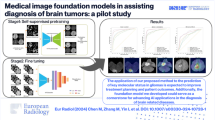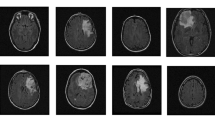Abstract
Purpose
Contrast-enhanced ultrasound (CEUS) imaging of tissue perfusion is based on microbubble echo detection. CEUS can visualize tumors based on local perfusion variations. The acquired video data are qualitatively interpreted by subjective visualization in clinical practice. An automated CEUS classifier was developed for intraoperative identification of tumor tissue and especially tumor borders.
Methods
Support vector machines (SVM) were trained using CEU data sets to differentiate tumor and non-tumor tissue in glioblastoma patients. The classification was based on features derived from model functions approximated to time courses for each pixel in the video data. Classification performance was evaluated with single and cross- patient training data sets.
Results
The minimum mean classification error (14.6 %) with single patient data set training was achieved by SVM training using a sigmoid combination of model function parameter sets. A comparison of different model functions showed that the minimum average classification error (17.4 %) in a cross-validation study with 13 patients was achieved with the sigmoid model using an automatic relevance detection kernel.
Conclusion
CEUS-based classification map images derived from approximated model functions can be generated with moderate accuracy and have significant potential to support intraoperative decisions concerning glioblastoma tumor borders.






Similar content being viewed by others
References
Albrecht T, Oldenburg A, Homann J, Skrok J, Hoffmann C, Schettler S, Wolf K (2003) Imaging of liver metastases with contrast-specific low-MI real-time ultrasound and SonoVue. Eur Radiol 13(3):79–86
Boser BE, Guyon IM, Vapnik V (1992). A training algorithm for optimal margin classifiers. In: Proceedings of workshop on computational learning theory (COLT), pp 144–152
Claudon M, Cosgrove D, Albrecht T, Bolondi L, Bosio M (2008) Guidlines and good clinical practice recommendations for contrast enhanced ultrasound (CEUS). Eur J Ultrasound 29:28–44
Cortes C, Vapnik V (1995) Support-vector networks. Mach Learn 20:273–297
Engelhardt M, Hansen C, Eyding J, Wilkening W, Brenke C, Krogias C, Scholz M, Harders A, Ermert H, Schmieder K (2005) Intraoperative contrast enhanced perfusion imaging of cerebral tumors. In: IEEE ultrasonics symposium, pp 743–746. IEEE
Engelhardt M, Hansen C, Eyding J, Wilkening W, Brenke C, Krogias C, Scholz M, Harders A, Ermert H, Schmieder K (2007) Feasibility of contrast-enhanced sonography during resection of cerebral tumours: initial results of a prospective study. Ultrasound Med Biol 33(4):571–575
Eyding J, Hölscher T, Postert T (2007) Transkranielle Neurosonologie beim akuten Schlaganfall. Deutsches Ärtzteblatt 6:340–346
Guo Y, Hastie T, Tibishirani R (2007) Regularized linear discriminant analysis and its application in microarrays. Biostatistics 8:86–100
Hamilton WF, Moore JW, Kinsman JM, Spurling RG (1928) Simultaneous determination of the pulmonary and systemic circulation times in man and of a figure related to cardiac output. Am J Physiol 84:338–344
Hansen C (2009) Kontrastmittelspezifische Ultraschall-Computertomographie. Dissertation, Ruhr-Universität Bochum, Bochum, Deutschland
Hardesty D, Snai N (2012) The value of glioma extent of resection in the modern neurosurgical era. Front Neurol 3:140
Hashizume H, Baluk P, Morikawa S (2000) Openings between defective endothelial cells explain tumor vessel leakiness. Am J Pathol 156:1363–1380
He W, Jiang X, Wang S, Liu H et al (2008) Intraoperative contrast-enhanced ultrasound for brain tumors. Clin Imaging 32:419–424
Helminger G, Yuan F, Delian M (1997) Interstitial H and pO\(_2\) gradients in solid tumors in vivo: high-resolution measurments reveal a lack of correlation. Nat Rev 3:177–182
Igel C, Hüsken M (2000) Improving the Rprop learning algorithm. In: Proceedings of the second international symposium on neural computation, pp 115–121
Jain R, Munn L, Fukumara D (2002) Dissecting tumor pathophysiology using intravital microscopy. Nat Rev Cancer 2:266–276
Madsen MT (1992) A simplified formulation of the gamma variate function. Phys Med Biol 37:370–377
Nemec U, Nemec S, Novotny C, Weber M, Czerny C, Krestan CK (2012) Quantitative evaluation of contrast-enhanced ultrasound after intravenous administration of a microbubble contrast agent for differentiation of benign and malignant thyroid nodules: assessment of diagnostic accuracy. Eur Radiol 22:1357–1365
Riedmiller M (1994) Advanced supervised learning in multilayer perceptrons—from backpropagation to adaptive learning algorithms. Int J Comput Stand Interfaces 16:265–278
Ritschel K, Dekomien C, Winter S (2012) Modellfunktion zur Approximation von Ultraschallkontrastmittelkonzentration zur semi-quantitativen Gewebeperfusionsbestimmung. In: Proceedings of Bildverarbeitung für die Medizin (BVM), pp 159–164
Ritschel K, Pechlivanis I, Kensey I, Risse R, Winter S (2013) Perfusion model approximation in cerebral tumours: feature images and computation times. Biomed Technik 58(1):627–628
Sanai N, Berger M (2008) Glioma extent of resection and its impact on patient outcome. Neurosurgery 62:753–764
Sanai N, Polley M (2011) McDermott: an extent of resection threshold for newly diagnosed glioblastomas. J Neurosurg 115:3–8
Seidel G, Meairs S (2009) Ultrasound contrast agents in ischemic stroke. Cerebrovasc Dis 2:25–39
Serra C, Stauffer A, Actor B, Bernays R et al (2012) Intraoperative high frequency ultrasound in intracerebral high-grade tumors. Eur J Ultrasound 33:306–312
Smith J, Chang E, Lamborn K, Cha S et al (2008) Role of extent of resection in the long-term outcome of low-grade hemispheric gliomas. J Clin Oncol 26:1338–1345
Vicenzini E, Delfini R, Magri F, Santoro A et al (2008) Semiquantitative human cerebral perfusion assessment with ultrasound in brain space occupying lesions: preliminary data. J Ultrasound Med 27:685–692
Author information
Authors and Affiliations
Corresponding author
Rights and permissions
About this article
Cite this article
Ritschel, K., Pechlivanis, I. & Winter, S. Brain tumor classification on intraoperative contrast-enhanced ultrasound. Int J CARS 10, 531–540 (2015). https://doi.org/10.1007/s11548-014-1089-6
Received:
Accepted:
Published:
Issue Date:
DOI: https://doi.org/10.1007/s11548-014-1089-6




